The kickoff has traditionally been one of the most exciting plays in football. I remember the joy of watching Devin Hester in his prime. Every time he touched the ball, everyone held their breath! But the excitement goes hand-in-hand with danger and injury risk, and the NFL determined the violent full-speed collisions on kickoffs were too dangerous. So, in 2011, the NFL moved the kick from the 30 yard line to the 35 yard line, along with limiting the running start by the kickoff team to 5 yards. The hope was to increase touchbacks and reduce the speed of collisions. It worked! They further attempted to discourage returns for the 2016 season when they moved the touchback starting position from the 20 yard line to the 25 yard line.
I was curious what the actual 2011 and 2016 rules changes did to the kickoff. How much less of a factor is the kickoff than it once was? How has it impacted the decision to bring a kick out of the endzone. Here’s what I found:
The Efficient Return Hypothesis
Below is a chart of the average kickoff return location by NFL season. I pulled every kickoff dating back to 1999. The kickoffs are broken down into three lines. In blue, you see all kickoffs, in green are kickoffs that started outside of the endzone, and in orange are kickoffs where the returner decided to take it out of the endzon (instead of accepting a touchback).
At the 2011 season, the average return dropped significantly because they moved the kicks up five yards. This was ok because the returns were still going beyond the 20 yard line, which is better than a touchback. Once the NFL switched to the 25 yard line touchback, returns taken out of the endzone started to underperform the touchback. After the first two seasons of the rule change, kick returners seem to have adjusted and the average start position reached parity with the touchback.
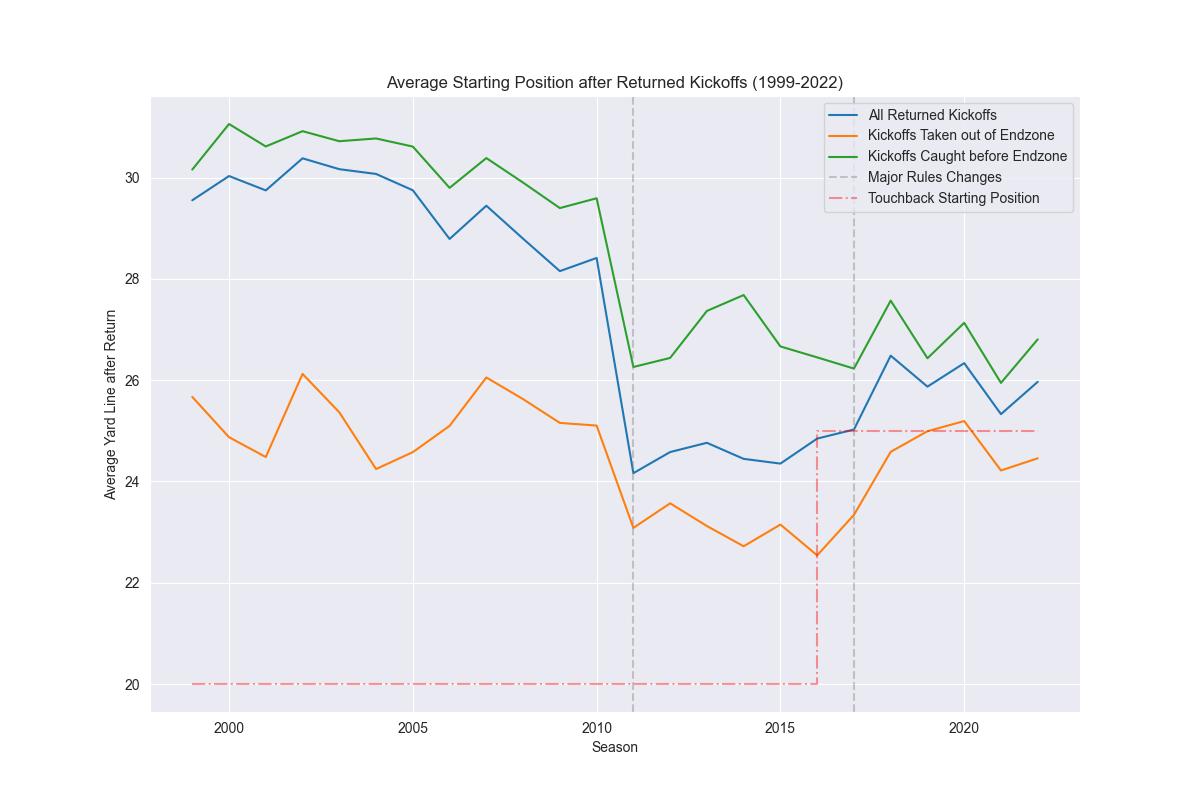
If we look only at the post-2016 returns, we see that the average has been very close to the touchback. Over this period, the average end of the return is the 24 yard line. Is it worth the effort? If you look at the distribution, you see the tantalizing right tail. There’s a little bump at the 100 yard line, where the rare touchdown took place. In addition to the upside, there is not that much downside; almost all returns went beyond the 10 yard line.
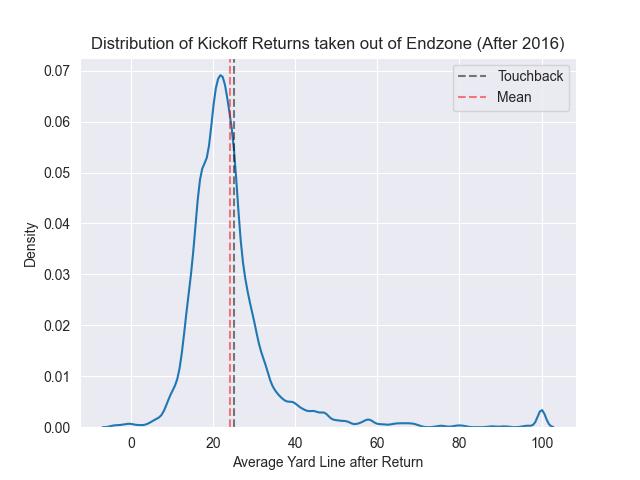
It’s interesting that we can see this clear shock to the equilibrium after the 2016 rule change and then we see the returns approach equilibrium quickly. And it makes perfect economic sense! The value of the alternative is the 25 yard line, so returners become more selective (choosing only high-potential kicks to take out the endzone) until their expected value equals that of the alternative. The market for kickoff returns is efficient. I’m curious how, in practice, this worked out. Did special teams coaches train returners on what was a good kick to take out? Or did the returners just learn through their experiences in the 2016 and 2017 season?
The Decision to Bring a Kick Out
As is obvious to any casual observer who remembers the old days, the NFL was very successful in their stated goal of reducing kick returns and related injuries. In 2000, 10% of kickoffs were touchbacks, compared to 60% in the most recent season.
The increase was sharpest after the move to the 35 yard line and it’s unclear if the move to the 25 yard touchback made an impact, as there is little visible change in the generally-upward trend in 2016. While this may seem counter intuitive, it makes sense that the kicking teams would adjust their strategies to the rule change, as well. For example, there is evidence that once the touchback was extended to the 25 yard line, kicking teams started to kick the ball higher and shorter to avoid conceding the extra five yards.
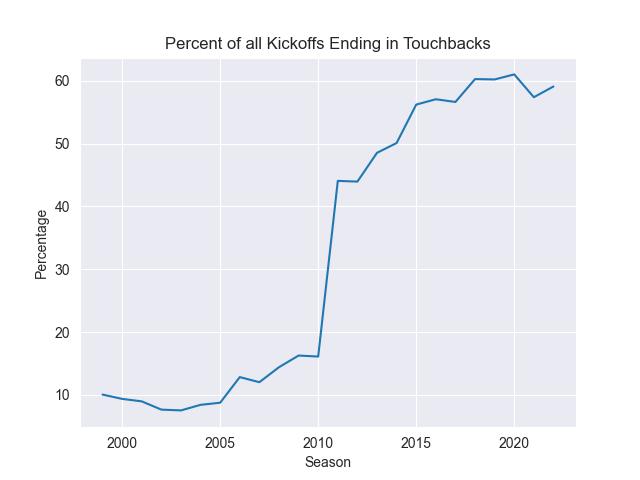
In addition to the increased touchbacks, fewer kicks were taken out of the endzone. Less than 20% of kicks that enter the endzone are taken out in today’s game, whereas over half were up until the 2011 rule change. Again, we see a large change in 2011 when the kickoff team moved closer, implying that much of this effect is because the kicks now go deeper into the endzone. There does not appear to be a change in the general trend in 2016, when the alternative to taking a kick out of the endzone became more attractive. There was a large downward movement from 2011 to 2016, after which the trend plateaued.
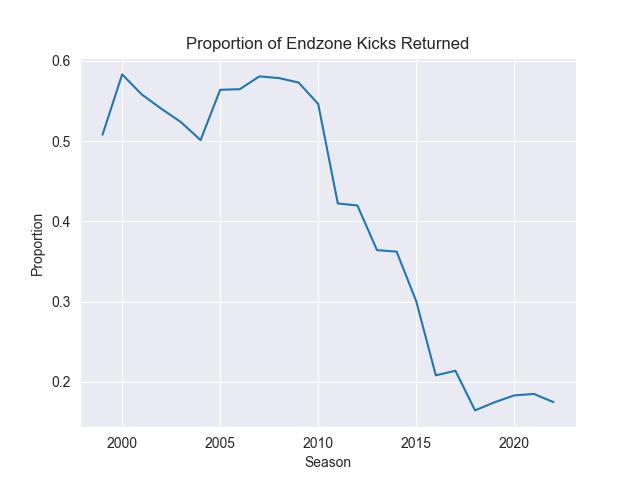
If we look at the following comparison between the depths of kicks taken out of the endzone before the 2011 rule change and after, something interesting emerges. Before the kickoff moved to the 35 yard line, the kickoffs taken out of the endzone had a much more uniform distribution. Basically, 5 yards into the endzone and less were all taken with similar frequency, and it wasn’t unheard of to take a kick out from 8 or 9 yards! In more recent, years, that is unthinkable. Almost no kicks are taken out if they’re beyond 3 yards deep into the endzone. So why should the depths at which returners will take the ball out change so much? Well, clearly what matters is less the kick depth but more the proximity of the kickoff team. Returners had no problem taking deep kicks out, but that was when they had an additional 5 yards of distance from their would-be tacklers.
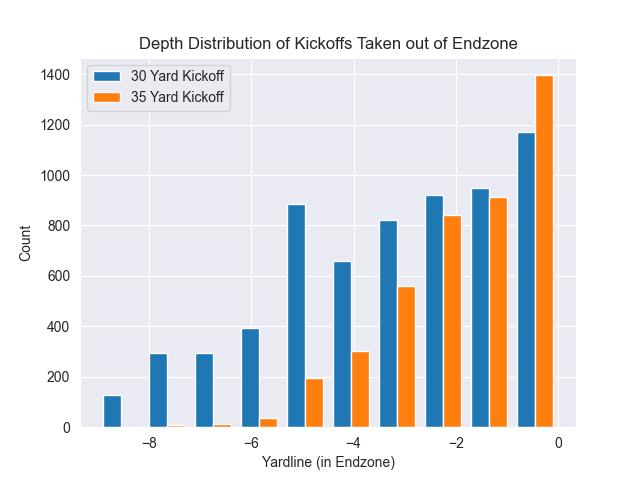
The End of the Kickoff Return
If we look at kickoff return touchdowns over time, it’s not clear that the rule change has killed the kickoff return. There’s clearly a higher average return touchdowns per year before the rule change, but it’s not that obvious. There were a few historic kickoff returners like Devin Hester and Joshua Cribbs in their prime during these seasons. Maybe the returners in recent years were just worse.

The effect becomes crystal clear if we look at the number of kickoffs that reached past midfield. The dropoff is stark and obvious after 2011. Great returns declined from 80 per season to 25. There aren’t even enough great returns for every team to have one. This is the true death of the kickoff return. It’ still true that in most cases, the kickoff return only makes a difference of 5 or 10 yards one way or the other. However, before 2011, there was a reasonable chance of a great kickoff return, which could jumpstart a drive and legitimately impact the game’s momentum and outcome. Now, it is exceptionally rare that a kickoff return dramatically impacts a game.
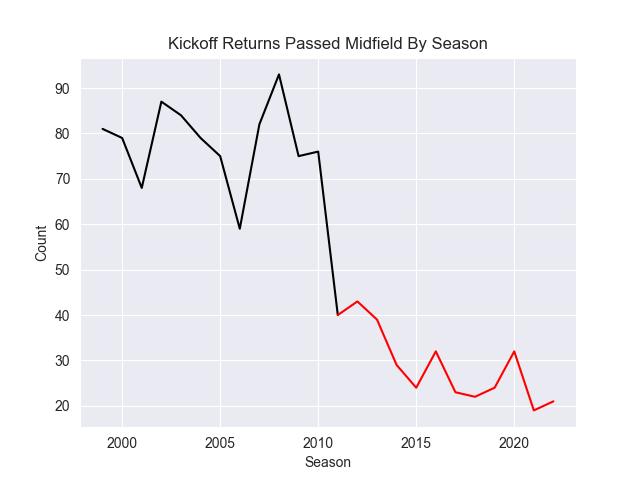
Conclusions
The NFL set out to destroy the kickoff and it was successful. Returns today are infrequent because touchbacks are pretty much just as good, so returners sparingly take kicks out of the endzone. It has become exceptionally rare to see great kickoff returns.